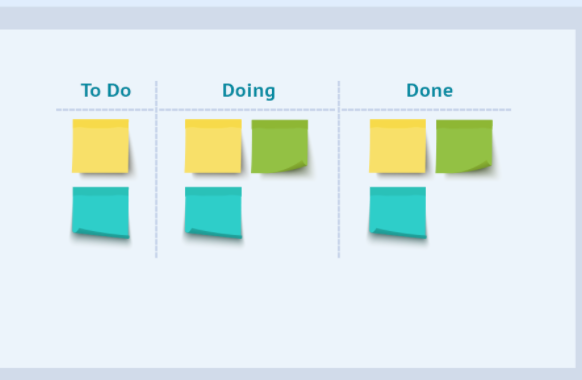To-do list is one of the more common tools in the arsenal of someone trying to stay on top of things. The idea is very simple, you write down a list of things that you need to do, be it in an app on your phone or on a piece of paper, and keep checking them off one by one. The part of checking off things from your list is indeed very satisfying. Personally for me too, I have found that I am much more likely to do a task if I write it in my to-do list AND I actually refer back to the list frequently. While to-do lists are helpful, they also have a bad reputation of being overwhelming and making you feel that you are not doing enough.

This is where the idea of Kanban board that I recently read about in the book, The Personal Kanban, tries to help. The Japanese word, Kanban, means ‘visual board’ or a ‘sign’. The use of Kanban in the sense of a process was first developed and applied by Toyota as a scheduling system for just-in-time manufacturing.
The use of Kanban board is simple to get started with. In the most basic version, one can get started with a three column system. One column would be for all the tasks to do. As one gets ready to do a task, they will move it to Doing, and then when the task is done, they can feel the satisfaction of moving it to Done. This can be done in an application (examples include Notion, Trello or Quip), or you can use standard sticky-notes and move them around.

One of the key parts of a Kanban board is that all the columns are important, including the Done column which is not generally the case with To-do lists. In standard To-do lists, items checked off either disappear by themselves if you are using an app, or you can strike-through them to make them less important. Either way, the work that you have accomplished tends to be neglected and the focus is only on what you have to do.
Why bother with the Done column?

It may seem that only the tasks that we have to do should be important to look at but the Done column can have its charm too. In work setting, it’s likely that your manager will ask you to prepare a work summary of all your accomplishments so that they can make a case for your promotion. If you have already been tracking your work and accumulating items in your Done column, you would have a much easier time putting everything important you have done (Writing that document and more importantly, selling yourself would probably still be difficult but that’s for another post).
Perhaps even more importantly, a Done column can help us not be too hard on ourselves because while our things to do are expanding, things we have done are also expanding. In other words, a Kanban board can help us also focus on the gains that we have made, and not just the gaps that remain to be filled.
Added extra benefit, it can also help us with these conversations:
Borrowed from this article

As for me personally, I have recently starting experimenting with a Kanban board. It is actually more satisfying to move a task from Doing to Done column than just checking off something on To-do list. I haven’t discarded my To-do list completely though and my tasks in Todoist are still growing but I definitely see some potential benefits of Kanban board, and want to try it more. Let me know if you are interested in trying it out and if I can help with any of the apps mentioned!